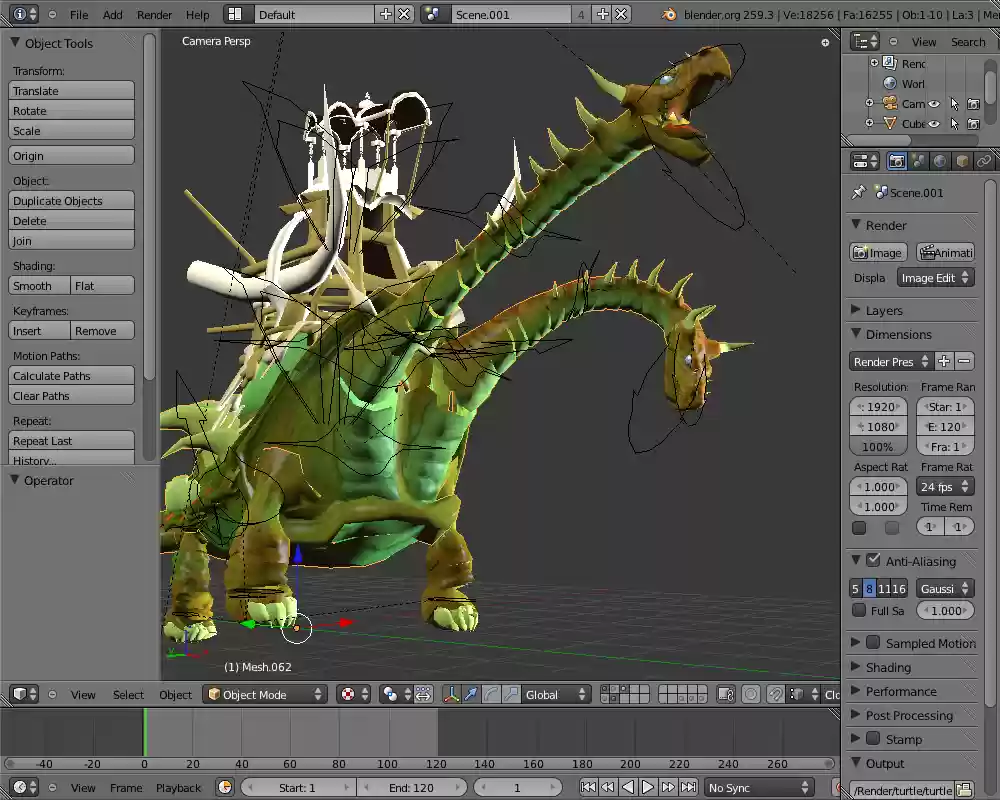Blender online 3D movies creation suite
Ad

Blender is a computer graphics software with the help of which you can create, animated films, art, 3D-printed models, motion graphics, visual effects, interactive 3D applications, and visual reality. Formerly Blender 3d is used for the game engine. The first release was around 28 years ago, and since then it is one of the favorite applications to use for creating mind-blowing graphics.
OffiDocs offers online Blender 3d for free which you can use to create whatever you would like. Consider Blender as a 360 movie creation suite that is very powerful to create perfect graphics.
Blender 3D Functions & Features
Our online Blender 3D creation suite supports the entirety of the 3D pipeline - modeling, rigging, animation, simulation, rendering, compositing and motion tracking, video editing, and 2D animation pipeline.
Blender is chock full of useful tools, but some will be more relevant to beginners than others. For many coming to Blender, the most popular tools are modeling, sculpting, and texturing, as well as animation. Those creating objects for 3D printing may not even go beyond modeling and sculpting. However, for those who are interested in exploring the more advanced 3D techniques and tools, you’ll want to check out the 2D/3D hybrid Grease Pencil, physics simulations, scripting, and visual effects.
1. Modeling & Sculpting
The most powerful and useful features that Blender offers are its 3D modeling and sculpting tools. After all, there’s no 3D art without 3D objects! There are a number of ways you can approach creating a 3D model in Blender, and the latest version (2.8) available in OffiDocs makes it even easier to utilize these methods.
● Mesh-based modeling is the most commonly used approach, also called surface modeling or box modeling. This method works on a polygon to polygon basis, where objects are constructed out of individual surfaces, sometimes even one vertex at a time.
● Similar to this method is the curve-based method, called NURBS modeling in Blender, which instead uses lines to define objects. This approach involves drawing guiding structural lines, which are then used to generate the mesh.
● Sculpting has a variety of tools used to ‘push’ and ‘pull’ the mesh in different ways, similar to how a traditional artist might sculpt clay. This method works best when there are a lot of polygons, and is generally used to create highly detailed and textured objects.
2. Texturing & UV Unwrapping
Once you’ve created a model, if you aren’t rushing off to 3D print it, you may want to make it look pretty with some color! This is where texturing and UV mapping comes into play. Blender offers a powerful engine for the creation of materials and textures. These allow you to create a huge variety of appearances for your objects.
The UV unwrapping tool lets you flatten out the surface of your model so you can paint on your own texture. You can then adjust all sorts of things such as opacity, diffusion, light reflection, or back-lighting to get just the effect you are looking for.
3. Rigging & Animation
If you don’t want to see your model just sitting around looking pretty, you may want to explore Blender’s rigging and animation tools. These will allow you to essentially put a skeleton inside your model and make it move and dance however you choose!
You don’t need to use rigging for basic animation: You can animate just about any movement in Blender by ‘keying‘ it into the animation timeline. This is basically a stop-motion method, where you create points in the animation timeline. This is all you need if you want something to fly around or move from point A to point B.
For more complex animation, especially if you want to animate a character, you’ll need to use Blender’s rigging tools. With these, you can get your model moving exactly the way you want. What’s great is that Blender will automatically fill in the movement in between your keyframes. You just need to set the starting and ending pose, and Blender will fill the movement in between. It can take some fiddling though, which is where the art of the animator comes in.
YouTube Tutorial - Blender
For your better understanding, the OffiDocs team has created a youtube tutorial. Click on the video below to watch how easily you can work on your next 3d project.
Additional Features to Explore
Beyond the primary tools, there’s a lot to discover in Blender!
1. The Grease Pencil is a fascinating and popular tool that allows you to paint in 3D space using 2D brushes.
2. You can create 2D animations using a hybrid workspace.
3. Physics simulations such as gravity, cloth, and generated hair are fun to use.
4. Other cool ones to play with are fire, smoke, or liquid particle effects.
5. Blender’s powerful rendering engine lets you output your images and designs in a variety of formats and resolutions.
6. There are lots of video editing and visual effects that can turn your renders into fully-qualified animations. Blender’s built-in scripting lets you shape the program to your needs.














